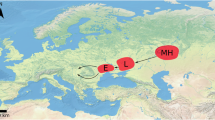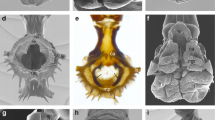Abstract
The karyological information gathered for the Indian spiders taxa thus far were cytologically derived from only few species but none for the representatives belonging to the genus Ctenus. Ctenus indicus (Gravely 1931), an Indian ctenid spider was cytogenetically analyzed following conventional, C- and NOR-banding techniques so as to gather substantial data for future course of understanding of karyotypic evolution among spider species. The karyotypic data for Ctenus indicus revealed the complement consisting of (2n = 28) 26AA + X1X2♂ and (2n = 30) 26AA + X1X1X2X2♀ acrocentric chromosomes. A closer scrutiny of meiotic progression disclosed many male pachytenic cells displaying the occurrence of ‘bouquet’ formation. The results of C-banding enabled in identifying centromeric constitutive heterochromatin locales, and in some chromosomes also the distal ends of telomeric regions. Silver nitrate stained NOR-specifications were noticed at the distal telomeric regions of two pairs of chromosomes (#8 and #10) in the complement. Cytological evidence procured from the present study not only adds to the ever-growing list of the spider cytogenetic assessments but also offers as a baseline data towards establishing evolutionary relationships within this important group.


Similar content being viewed by others
References
Amor DJ, Andy Choo KH. Neocentromeres: role in human disease, evolution, and centromere study. Am J Hum Genet. 2002;71:695–714.
Araujo D, Cella DM, Brescovit AD. Cytogenetic analysis of the neotropical spider Nephilengys cruentata (Araneomorphae, Tetragnathidae): standard staining, NORs, C-bands and base-specific fluorochromes. Braz J Biol. 2005;65:193–202.
Araujo D, Rheims CA, Brescovit AD, Cella DM. Extreme degree of chromosome number variability in species of the spider genus Scytodes (Araneae, Haplogynae, Scytodidae). J Zool Syst Evol Res. 2008;46:89–95.
Araujo D, Mattos VF, Giroti AM, Kraeski MG, Carvalho LS, Brecovit AD. Cytogenetical characterization of six orb-weaver species and review of cytogenetical data for Araneidae. J Arachnol. 2011;39:337–44.
Araujo D, Schneider MC, Paula-Neto E, Cella DM. Sex chromosomes and meiosis in spiders: a review. In: Swan A, editor. Meiosis—molecular mechanisms and cytogenetic diversity. Rijeka: InTech; 2012. p. 87–108.
Araujo D, Oliveira EGD, Giroti AM, Mattos VF, Paula-Neto E, Brescovit AD, Schneider MC, Cella DM. Comparative cytogenetics of seven Ctenidae spiders (Araneae). Zool Sci. 2014;31:83–8.
Babu A, Verma RS. Chromosome structure: euchromatin and heterochromatin. Int Rev Cytol. 1987;108:1–60.
Bole-Gowda BN. A study of the chromosomes during meiosis in twenty-two species of Indian spiders. Proc Zool Soc Bengal. 1958;11:69–108.
Carpenter AT. Gene conversion, recombination nodules, and the initiation of meiotic synapsis. BioEssays. 1987;6:232–6.
Chemisquy MA, Gil SGR, Scioscia CL, Mola LM. Cytogenetic studies of three Lycosidae species from Argentina (Arachnida, Araneae). Genet Mol Biol. 2008;31:857–67.
Chen SH. Cytological studies on six species of spiders from Taiwan (Araneae: Theridiidae, Psechridae, Uloboridae, Oxyopidae, and Ctenidae). Zool Stud Taipei. 1999;38:423–4.
Chowdaiah BN, Venkatachalaiah G. Air drying technique for the preparation of mosquito chromosomes. Nucleus. 1987;30:44–6.
Coddington JA. Phylogeny and classification of spiders. Spiders of North America: An identification manual. Am Arachnol Soc. 2005;27:18–24.
Datta SN, Chatterjee K. Chromosomes and sex determination in three species of spinner spiders from northeastern India. Cell Chromosom Res. 1992;15:64–9.
Dolejš P, Kořínkova T, Musilová J, Opatová V, Kubcová L, Buchar J, Král J. Karyotypes of central European spiders of the genera Arctosa, Tricca and Xerolycosa (Araneae: Lycosidae). Eur J Entomol. 2011;108:1–16.
Driscoll DJ, Palmer CG, Melman A. Nonhomologous associations of C-heterochromatin at human male meiotic prophase. Cytogenet Cell Genet. 1979;23:23–32.
Forman M, Nguyen P, Hula V, Král J. Sex chromosome pairing and extensive NOR polymorphism in Wadicosa fidelis (Araneae: Lycosidae). Cytogenet Genome Res. 2013;141:43–9.
Gorlov IP, Gorlova OYU, Logunov DV. Cytogenetic studies on Siberian spiders. Hereditas. 1995;122:211–20.
Haaf T, Warburton PE, Willard HF. Integration of human α-satellite DNA into simian chromosomes: centromere protein binding and disruption of normal chromosome segregation. Cell. 1992;70:681–96.
Howell WM, Black DA. Controlled silver-staining of nucleolus organizer regions with a protective colloidal developer: a 1-step method. Experientia. 1980;36:1014–5.
Jong JD, Stam P. The association of centromeres of nonhomologous chromosomes at meiotic prophase in Beta vulgaris L. Can J Genet Cytol. 1985;27:165–71.
Král J, Musilová J, Št’áhlavský F, Řezáč M, Akan Z, Edwards RL, Coyle FA, Almerje CR. Evolution of the karyotype and sex chromosome systems in basal clades of araneomorph spiders (Araneae: Araneomorphae). Chrom Res. 2006;14:859–80.
Král J. Evolution of multiple sex chromosomes in the spider genus Malthonica (Araneae: Agelenidae) indicates unique structure of the spider sex chromosomes systems. Chrom Res. 2007;15:863–79.
Král J, Korínková T, Forman M, Krkavcová L. Insights into the meiotic behavior and evolution of multiple sex chromosome systems in spiders. Cyt Genome Res. 2011;133:43–66.
Král J, Korínková T, Krkavcová L, Musilová J, Forman M, Herrera IMÁ, Haddad CR, Vitkova M, Henriques S, Vargas JGP, Hedin M. Evolution of karyotype, sex chromosomes, and meiosis in mygalomorph spiders (Araneae:Mygalomorphae). Biol J Linn Soc. 2013;109:377–408.
Levan A, Fredga K, Sandberg AA. Nomenclature for centromeric position on chromosomes. Hereditas. 1964;52:201–20.
Loidl J. The initiation of meiotic chromosome pairing: the cytological view. Genome. 1990;33:759–78.
McKee BD, Handel MA. Sex chromosomes, re-combination, and chromatin conformation. Chromosoma. 1993;102:71–80.
Miller DA, Dew V, Tantravahi R, Miller O. Suppression of human nucleolar organizer activity in mouse human somatic hybrid cells. Exp Cell Res. 1976;101:235–43.
Mittal OP. Karyological studies on the Indian spiders. VI. Chromosome number and sex determining mechanism in the family Araneidae. Res Bull Panjab Univ. 1966;17:335–51.
Oliveira EG, Cella DM, Brescovit AD. The karyotype of Loxosceles gaucho and Ctenus Ornatus (Arachnida, Araneae, Sicariidae, Ctenidae). Rev Brasil Genét. 1996;18:128.
Oliveira RM, Jesus AC, Brescovit AD, Cella DM. Chromosomes of Crossopriza lyoni (Blackwall 1867), intraindividual numerical chromosome variation in Physocyclus globosus (Taczanowski 1874), and the distribution pattern of NORs (Araneomorphae, Haplogynae, Pholcidae). J Arachnol. 2007;35:293–306.
Parida BB, Sharma NN. Chromosome number, sex mechanism and genome size in 2 species of Indian spiders. Chrom Inf Serv. 1987;43:11–3.
Polotow D, Brescovit AD. Revision and cladistic analysis of Isoctenus and description of a new neotropical genus (Araneae, Ctenidae, Cteninae). Zool J Linn Soc. 2009;155(3):583–614.
Polotow D, Brescovit AD. Phylogenetic analysis of the tropical wolf spider subfamily Cteninae (Arachnida, Araneae, Ctenidae). Zool J Linn Soc. 2014;170:333–61.
Polotow D, Carmichael A, Griswold CE. Total evidence analysis of the phylogenetic relationships of Lycosoidea spiders (Araneae, Entelegynae). Invert Syst. 2015;29(2):124–63.
Postiglioni A, Brum-Zorrilla N. Karyological studies on Uruguayan spiders II. Sex chromosome in spiders of the genus Lycosa (Araneae-Lycosidae). Genetica. 1981;56:47–53.
Sebastian PA, Peter KV. Spiders of India. Hyderabad: Universities Press; 2009. p. 1–435.
Sharma GP, Tandon KK, Grewal MS. Cytological studies on Indian spiders.V. Chromosome complement and male meiosis in Hersilia savignyi Lucas(Hersiliidae), Larinia sp. (Argiopidae), Tetragnatha sp. (Tetragnathidae), Oxyopes sryvesii Pocock, and Oxyopes sp. (Oxyopidae). Res Bull Panjab Univ. 1960;11:201–6.
Sharma N, Parida BB. Study of chromosomes in spiders from Orissa. Pranikee. 1987;8:71–6.
Silva Davila D. Higher-level relationships of the spider family Ctenidae (Araneae: Ctenoidea). Bull Am Mus Nat His. 2003;274:1–86.
Sumner AT. A simple technique for demonstrating centromeric heterochromatin. Exp Cell Res. 1972;75:304–6.
World Spider Catalog. Natural history museum bern. http://wsc.nmbe.ch, version 17.0. Accessed 8 Sep 2016.
Acknowledgements
We are thankful to Dr. Sudhikumar AV, Assistant Professor of Zoology, Centre for Animal Taxonomy and Ecology, Department of Zoology, Christ College, Irinjalakuda, Kerala, India for assisting in the identification of spider samples. SA is grateful to University Grants Commission (SRF-16-1593/2012-14, SA-III) and Ministry of Human Resource Development (RGNF-UGC: 2010-12), New Delhi, for the financial support.
Author information
Authors and Affiliations
Corresponding author
Rights and permissions
About this article
Cite this article
Kumar, S.A., Venu, G., Jayaprakash, G. et al. Studies on chromosomal characteristics of Ctenus indicus (Gravely 1931) (Araneae: Ctenidae). Nucleus 60, 17–23 (2017). https://doi.org/10.1007/s13237-016-0191-2
Received:
Accepted:
Published:
Issue Date:
DOI: https://doi.org/10.1007/s13237-016-0191-2




